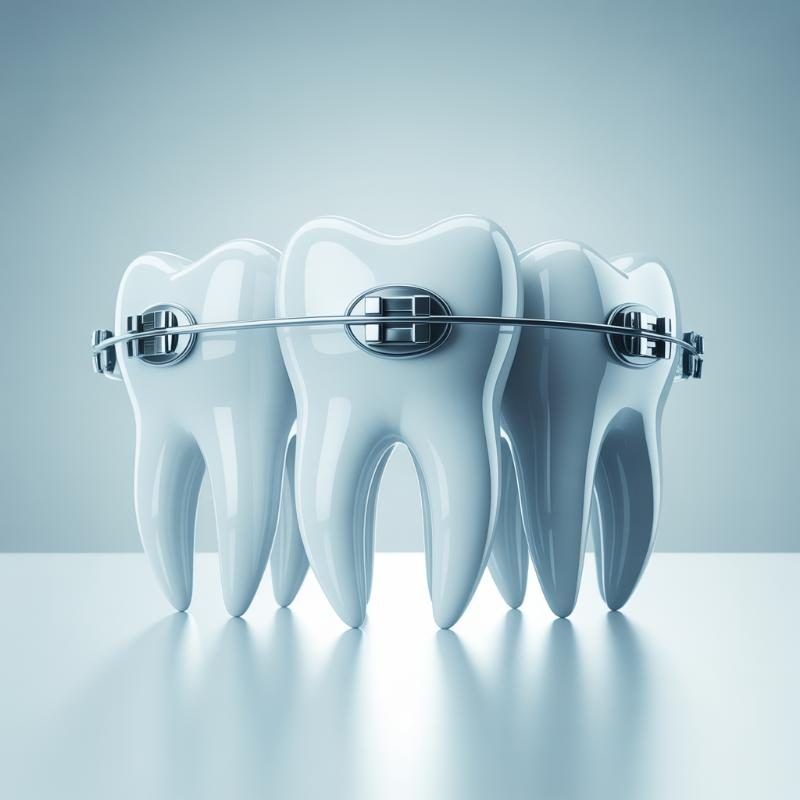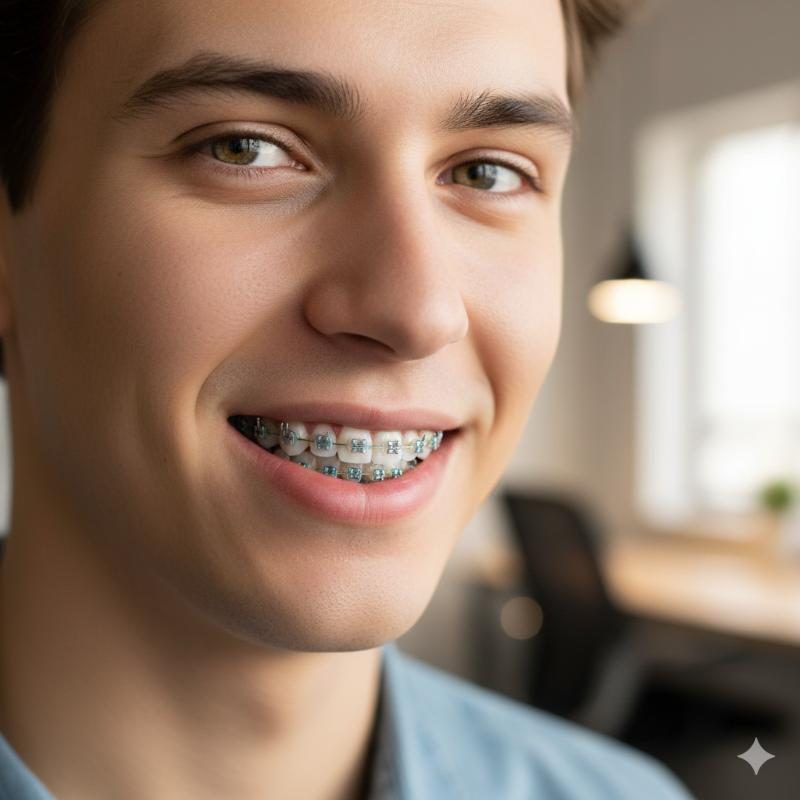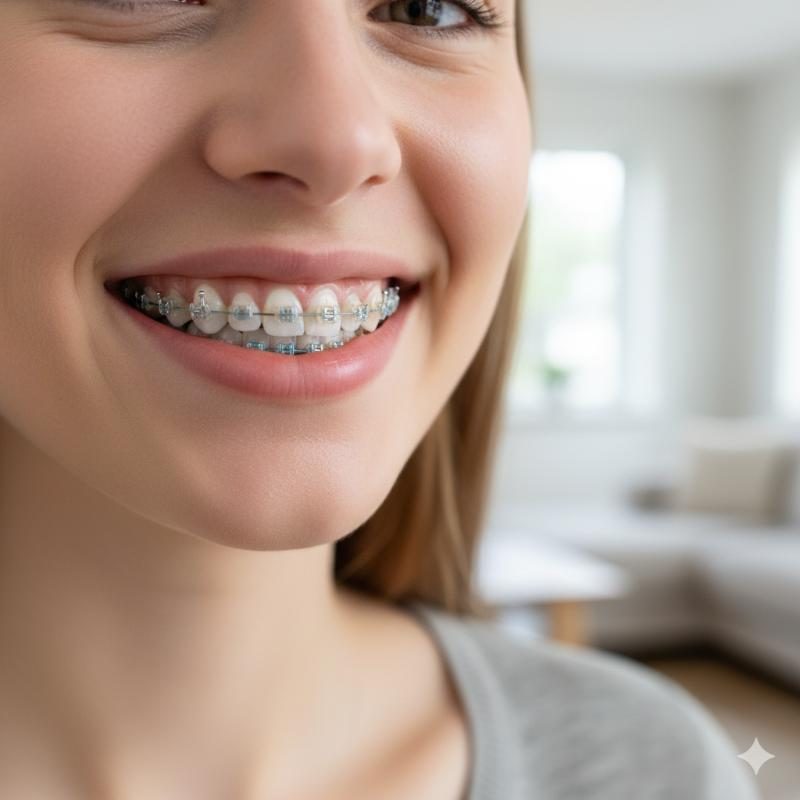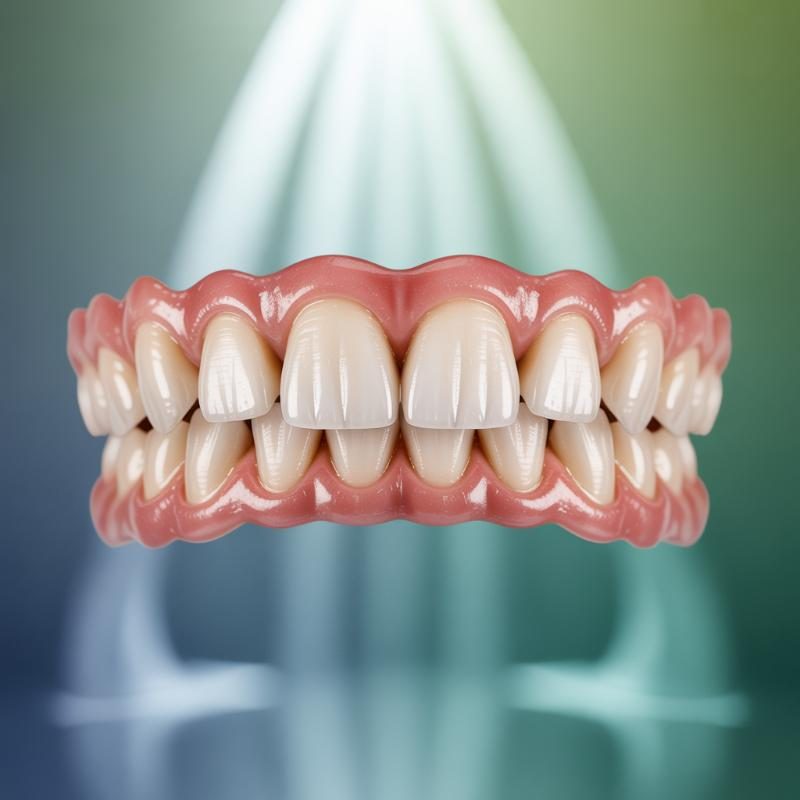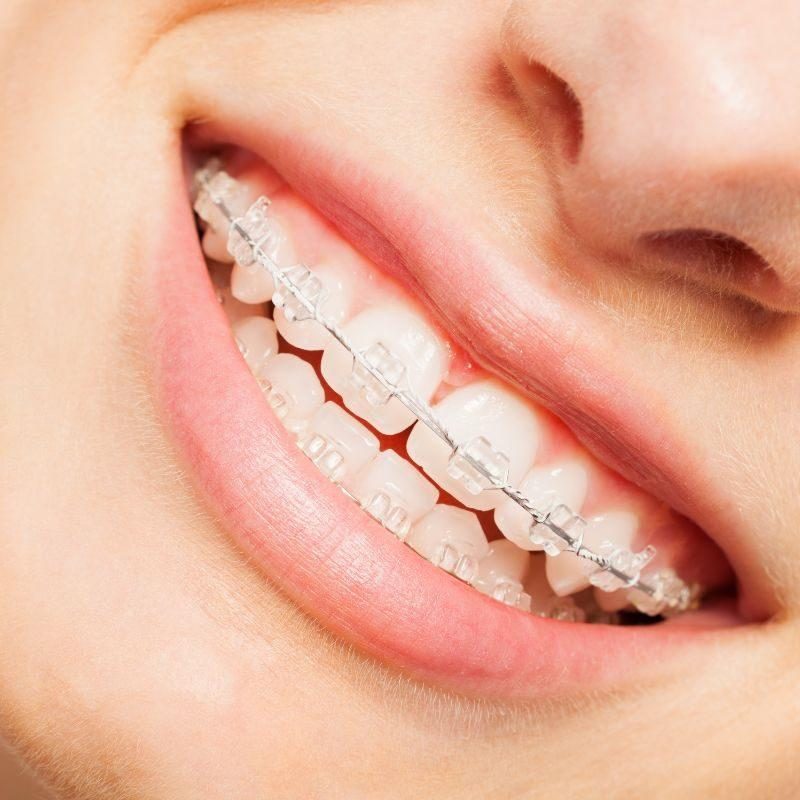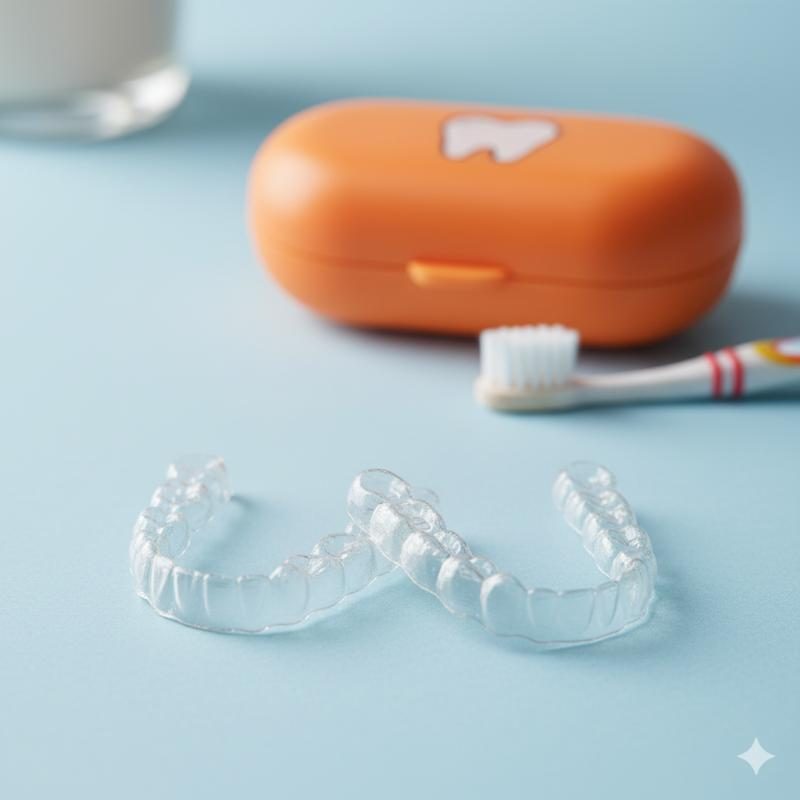Discover the differences between traditional metal braces and clear aligners. Learn which option works best for your smile goals.
Overview
When it comes to orthodontic treatment, traditional metal braces have been the cornerstone of effective teeth straightening for decades. These time-tested appliances use brackets, wires, and elastic bands to gradually move teeth into their proper positions, creating beautiful and functional smiles for millions of patients worldwide.
At Neighborhood Orthodontics in Riverview, FL, Dr. Ryan Ricafort combines the reliability of traditional metal braces with cutting-edge technology to deliver exceptional results. Our patients benefit from advanced systems like LightForce 3D-printed braces, which offer the proven effectiveness of metal braces with unprecedented customization and comfort.
How Traditional Metal Braces Work to Move Your Teeth
Traditional metal braces function through a carefully orchestrated system of gentle, continuous pressure applied to your teeth over time. The metal brackets are bonded to each tooth using a special dental adhesive, while archwires connect these brackets and provide the force needed to guide teeth into proper alignment. As Dr. Ricafort adjusts the wires during your regular appointments, your teeth gradually shift into their ideal positions.
The science behind traditional metal braces is based on the biological principle of bone remodeling. When pressure is applied to a tooth, the periodontal ligament surrounding the tooth root signals the bone to break down on one side and rebuild on the other. This process allows teeth to move safely and predictably through the jawbone, creating lasting orthodontic corrections that can transform both function and appearance.
Modern traditional metal braces are significantly smaller and more comfortable than their predecessors from decades past. The brackets are sleeker, the wires are more flexible yet effective, and the overall treatment experience is much more pleasant. Patients often find that after the initial adjustment period, wearing traditional metal braces becomes a natural part of their daily routine.
The versatility of traditional metal braces makes them suitable for correcting virtually any orthodontic problem, from simple spacing issues to complex bite misalignments. Whether you’re dealing with crowded teeth, gaps, overbites, underbites, or crossbites, traditional metal braces provide the precision and control needed to achieve your ideal smile.
Advanced Technology Behind Modern Traditional Metal Braces
Today’s traditional metal braces incorporate advanced materials and technologies that make treatment more efficient and comfortable than ever before. At Neighborhood Orthodontics, we utilize LightForce 3D-printed braces, which represent a revolutionary advancement in orthodontic care. Unlike conventional braces that use standardized brackets, LightForce braces are custom-designed for each individual patient’s teeth.
The LightForce system begins with a detailed digital scan of your mouth, eliminating the need for messy impressions. Dr. Ricafort uses specialized software to create a personalized treatment plan that maps out the exact movement needed for each tooth. Based on this digital plan, custom brackets are 3D-printed specifically for your teeth, ensuring optimal fit and more predictable results.
These custom traditional metal braces offer several advantages over conventional systems. The personalized fit reduces the need for frequent adjustments, potentially shortening overall treatment time. The precision of 3D printing technology also minimizes the likelihood of bracket failures and provides more comfortable treatment throughout your orthodontic journey.
Additional technological enhancements include heat-activated wires that respond to your body temperature, providing gentler yet more effective tooth movement. Self-ligating brackets eliminate the need for elastic ties, reducing friction and allowing teeth to move more freely. These innovations make traditional metal braces more efficient while maintaining the proven reliability that has made them the gold standard in orthodontics.
Who Benefits Most from Traditional Metal Braces Treatment
Traditional metal braces are particularly well-suited for patients with complex orthodontic needs that require precise control over tooth movement. Severe crowding, significant bite discrepancies, and cases involving impacted teeth often respond best to the comprehensive approach that traditional metal braces provide. The robust nature of metal brackets and wires allows orthodontists to apply the forces necessary to address even the most challenging alignment issues.
Teenagers often find traditional metal braces to be an excellent choice because they don’t require the high level of compliance needed with removable aligners. With brackets bonded directly to the teeth, there’s no risk of losing or forgetting to wear the appliance. This makes traditional metal braces particularly effective for younger patients who may not have developed the discipline required for removable orthodontic appliances.
Adults with complex orthodontic problems also benefit significantly from traditional metal braces. Cases involving significant bite corrections, rotated teeth, or the need to move roots as well as crowns typically achieve better results with traditional metal braces than with alternative treatments. The precision and control offered by brackets and wires make them indispensable for comprehensive orthodontic corrections.
Patients seeking the most cost-effective orthodontic treatment often find traditional metal braces to be the ideal choice. While the initial appearance may be more noticeable than clear alternatives, the proven effectiveness and typically lower cost make traditional metal braces an attractive option for families prioritizing results over aesthetics. Many patients discover that the temporary visibility of traditional metal braces is a small price to pay for the lasting benefits of a properly aligned smile.
Clear Aligners Explained: The Modern Alternative
Clear aligners represent a revolutionary approach to orthodontic treatment, offering patients a nearly invisible way to straighten their teeth. These custom-made, transparent plastic trays gradually move teeth into proper position through a series of precisely designed aligners that patients change every two to three weeks.
At Neighborhood Orthodontics, Dr. Ricafort provides clear aligner treatment for patients who prefer a more discreet orthodontic solution. Using advanced digital planning software and precise manufacturing techniques, clear aligners can effectively address many common orthodontic concerns while allowing patients to maintain their normal appearance throughout treatment.
The Science Behind Clear Aligner Technology
Clear aligners work by applying controlled forces to specific teeth through precisely designed plastic trays. Each aligner in the series is slightly different from the previous one, creating incremental movements that gradually guide teeth to their desired positions. The technology behind clear aligners relies on sophisticated computer modeling to predict tooth movement and design each stage of the treatment process.
The materials used in clear aligners have evolved significantly, with modern thermoplastic polymers providing the ideal balance of flexibility and strength needed to move teeth effectively. These materials are biocompatible and designed to maintain their shape and force delivery throughout the prescribed wearing period. The clarity of the material ensures that aligners remain virtually invisible when worn properly.
Digital treatment planning is crucial to the success of clear aligner therapy. Dr. Ricafort uses 3D imaging and computer simulations to map out the entire treatment process before it begins. This allows patients to visualize their expected results and ensures that each aligner is designed to achieve specific, predetermined tooth movements. The precision of this digital planning process is what makes clear aligners effective for many orthodontic corrections.
Manufacturing precision is equally important in clear aligner success. Each aligner must fit precisely to deliver the intended forces without causing discomfort or unwanted side effects. Advanced manufacturing techniques ensure consistent quality and accuracy across all aligners in a treatment series, providing predictable results when patients follow their prescribed wearing schedule.
Popular Clear Aligner Brands and Systems
The clear aligner market has expanded significantly in recent years, with various brands offering different approaches to invisible orthodontic treatment. Invisalign remains the most well-known and widely used clear aligner system, with decades of research and development behind its technology. The Invisalign system uses proprietary SmartTrack material and advanced treatment planning software to deliver predictable results for a wide range of orthodontic cases.
Other clear aligner systems available through orthodontic practices include ClearCorrect, Spark, and various in-office clear aligner programs. Each system has its own unique features and advantages, but all rely on the same basic principle of using sequential plastic trays to move teeth gradually. The key differences often lie in the materials used, the treatment planning software, and the level of doctor involvement in the treatment process.
At Neighborhood Orthodontics, Dr. Ricafort evaluates each patient’s individual needs to determine which clear aligner system, if any, would be most appropriate for their case. Factors such as the complexity of tooth movements needed, patient compliance expectations, and treatment timeline all influence the selection of the most suitable clear aligner approach.
It’s important to distinguish between professional clear aligner treatment provided by orthodontists and direct-to-consumer aligner companies. Professional treatment includes comprehensive examination, treatment planning by a qualified orthodontist, and ongoing monitoring throughout the process. This professional oversight is crucial for achieving safe, effective results and addressing any complications that may arise during treatment.
Ideal Candidates for Clear Aligner Treatment
Clear aligners work best for patients with mild to moderate orthodontic concerns who can commit to wearing their aligners for 20-22 hours per day. Good candidates typically have issues such as minor crowding, spacing problems, or mild bite discrepancies that don’t require complex tooth movements or significant bite corrections. Patient compliance is absolutely crucial for clear aligner success, as the removable nature of the appliances means treatment effectiveness depends entirely on consistent wear.
Adult patients often make excellent candidates for clear aligners because they typically have the discipline and motivation needed to wear their aligners consistently. Professional adults who are concerned about the appearance of traditional metal braces frequently choose clear aligners to maintain their professional image while improving their smile. The ability to remove aligners for important meetings, presentations, or social events provides flexibility that many adult patients value highly.
Teenagers can also be successful clear aligner candidates, but careful evaluation of maturity and compliance potential is essential. Some clear aligner systems include compliance indicators that help parents and orthodontists monitor whether aligners are being worn as prescribed. However, traditional metal braces may be more appropriate for teens who struggle with responsibility or who have complex orthodontic needs.
Patients with excellent oral hygiene habits tend to have better experiences with clear aligners, as the removable trays require diligent cleaning and maintenance. The ability to remove aligners for brushing and flossing can actually make oral hygiene easier during orthodontic treatment, but only if patients maintain consistent cleaning routines for both their teeth and their aligners.
Traditional Metal Braces vs Clear Aligners: Treatment Effectiveness
When comparing treatment effectiveness between traditional metal braces and clear aligners, several factors must be considered including the complexity of the orthodontic problem, treatment duration, and predictability of results. Both treatment options can achieve excellent outcomes when used appropriately for suitable cases.
Research consistently shows that both traditional metal braces and clear aligners can effectively treat many common orthodontic problems. However, the specific advantages of each approach become apparent when examining different types of cases and treatment goals. Understanding these differences helps patients and orthodontists select the most appropriate treatment for optimal results.
Complex Cases: Where Traditional Metal Braces Excel
Traditional metal braces demonstrate superior effectiveness in treating complex orthodontic cases that require significant tooth movements, bite corrections, or precise control over root positioning. Cases involving severe crowding, impacted teeth, or substantial vertical dimension changes typically achieve better results with traditional metal braces than with clear aligners. The ability to apply controlled forces in multiple directions simultaneously makes traditional metal braces indispensable for comprehensive orthodontic corrections.
Bite correction cases, particularly those involving significant overbites, underbites, or crossbites, often respond more predictably to traditional metal braces. The continuous force application and precise control offered by brackets and wires allow orthodontists to achieve the complex tooth movements necessary for proper bite alignment. Clear aligners, while effective for many cases, have limitations in their ability to achieve certain types of tooth movements required for comprehensive bite correction.
Cases requiring extraction of teeth followed by space closure typically progress more efficiently with traditional metal braces. The ability to apply controlled forces to move multiple teeth simultaneously makes traditional metal braces ideal for managing the complex movements required after tooth extractions. The precision and control offered by traditional metal braces ensure that extraction spaces close properly while maintaining proper alignment of adjacent teeth.
Patients with severely rotated teeth or those requiring significant root movement also benefit from the superior control offered by traditional metal braces. The direct attachment of brackets to teeth allows for precise application of rotational forces and control over root positioning that can be challenging to achieve with clear aligners. For these complex movements, traditional metal braces remain the gold standard in orthodontic treatment.
Mild to Moderate Cases: Comparing Results
For mild to moderate orthodontic cases, both traditional metal braces and clear aligners can achieve excellent results, with the choice often coming down to patient preference, lifestyle considerations, and compliance factors. Cases involving minor crowding, spacing issues, or slight bite discrepancies can be effectively treated with either approach when properly planned and executed by a qualified orthodontist.
Clear aligners have shown particular success in treating spacing cases where teeth need to be moved together to close gaps. The gentle, continuous pressure applied by aligners can effectively close small to moderate spaces between teeth while maintaining proper alignment. However, cases requiring significant space closure or those involving canine teeth may still be better suited to traditional metal braces due to the greater control they provide.
Minor crowding cases often respond well to clear aligners, particularly when expansion or interproximal reduction (IPR) can create the necessary space for alignment. The ability to visualize the entire treatment sequence digitally allows patients to understand their treatment plan and see their predicted results before beginning. This predictability can be particularly appealing for patients with mild to moderate orthodontic concerns.
Relapse cases, where teeth have shifted after previous orthodontic treatment, are often excellent candidates for clear aligner therapy. These cases typically involve minor movements to restore previous alignment, making them well-suited to the capabilities of clear aligners. The discrete nature of clear aligners makes them particularly attractive to adults addressing relapse issues who may be reluctant to return to traditional metal braces.
Treatment Speed and Predictability Factors
Treatment duration varies significantly between traditional metal braces and clear aligners depending on the specific case requirements and patient compliance. Traditional metal braces typically provide more predictable treatment timelines because they work continuously without relying on patient compliance for effectiveness. The continuous force application ensures consistent progress toward treatment goals throughout the entire treatment period.
Clear aligner treatment duration depends heavily on patient compliance, with successful cases requiring 20-22 hours of daily wear. Patients who fail to wear their aligners as prescribed will experience delayed progress and extended treatment times. However, compliant patients often appreciate the ability to remove their aligners for special occasions without significantly impacting their treatment timeline.
The predictability of results differs between the two treatment options based on case complexity and patient factors. Traditional metal braces offer high predictability for complex cases due to the direct control they provide over tooth movement. Clear aligners provide excellent predictability for appropriate cases when patients maintain proper compliance, but may require refinements or additional aligners to achieve optimal results.
Both treatment options benefit from regular monitoring by a qualified orthodontist to ensure progress is proceeding as planned. Traditional metal braces typically require adjustments every 4-6 weeks, while clear aligner patients may have check-ups every 6-8 weeks. This professional oversight is crucial for both treatment approaches to ensure optimal outcomes and address any issues that arise during treatment.
Appearance and Lifestyle Considerations
The decision between traditional metal braces and clear aligners often centers on appearance concerns and how each option fits into a patient’s daily lifestyle. Both treatments have distinct visual characteristics and practical implications that patients should carefully consider when making their orthodontic treatment decision.
Understanding how each option affects appearance, social interactions, and daily activities helps patients make informed choices that align with their personal preferences and lifestyle requirements. These factors can significantly impact treatment satisfaction and overall orthodontic experience.
Visibility: Traditional Metal Braces vs Clear Aligners
Traditional metal braces are clearly visible when smiling, speaking, or opening the mouth, which can be a primary concern for image-conscious patients. However, modern traditional metal braces are significantly smaller and less noticeable than older versions, and many patients find that the initial self-consciousness fades quickly as they adjust to their new appearance. The metal brackets and wires become part of their temporary look during the treatment journey toward a beautiful smile.
Clear aligners offer near-invisibility when worn properly, making them virtually undetectable in most social and professional situations. The transparent material blends seamlessly with natural teeth, allowing patients to smile confidently throughout their treatment. However, clear aligners can become slightly visible if they become stained or if attachments are needed to facilitate certain tooth movements, though these small composite buttons are still much less noticeable than traditional metal braces.
The psychological impact of appearance during orthodontic treatment varies significantly among patients. Some individuals embrace the temporary nature of traditional metal braces and view them as a badge of commitment to improving their smile. Others find that the visibility of traditional metal braces affects their confidence and prefer the discretion offered by clear aligners.
Photography and video considerations may influence appearance preferences, particularly for patients in public-facing careers or those who frequently attend social events. Clear aligners can be temporarily removed for important photos or presentations, while traditional metal braces remain visible throughout treatment. However, many patients find that the temporary visibility of traditional metal braces is worth the reliable results they provide.
Daily Life Impact and Social Confidence
Traditional metal braces become integrated into daily routines relatively quickly, with most patients adapting to speaking and eating normally within a few weeks of beginning treatment. While there may be an initial adjustment period for speech and eating, these temporary changes typically resolve as patients become accustomed to their braces. The permanent nature of traditional metal braces eliminates concerns about remembering to wear appliances or losing them during daily activities.
Clear aligners require more active management in daily life, as patients must remove them for eating and drinking anything other than water. This creates opportunities for aligners to be misplaced, damaged, or forgotten, which can impact treatment progress. However, many patients appreciate the freedom to eat whatever they want without dietary restrictions and the ability to maintain normal oral hygiene routines.
Social situations may be handled differently with each treatment option. Traditional metal braces patients learn to navigate social interactions with confidence, often finding that their concerns about appearance were greater than others’ actual reactions. Clear aligner patients can remove their aligners for special occasions, but must remember to reinsert them promptly to maintain treatment progress.
Exercise and sports participation may be easier with clear aligners, as they eliminate concerns about bracket injuries from contact sports or physical activities. However, traditional metal braces patients can use protective mouthguards when necessary and generally participate in most activities without significant restrictions. Both options require some consideration of physical activities, but neither should prevent patients from maintaining active lifestyles.
Professional and Academic Settings
Professional environments may influence the choice between traditional metal braces and clear aligners, particularly for adults in client-facing roles or those who frequently give presentations. Clear aligners offer the advantage of maintaining a professional appearance throughout treatment, which can be important for career advancement and client relationships. The ability to remove aligners for important meetings or presentations provides additional flexibility for professional demands.
Academic settings, particularly for college students and graduate students, may present different considerations. Traditional metal braces are commonly seen in academic environments and generally don’t carry social stigma among peers. However, students involved in public speaking, presentations, or leadership roles may prefer the discretion offered by clear aligners during important academic events.
Communication-intensive professions such as teaching, sales, or public relations may benefit from the clear appearance of aligners, though many professionals successfully navigate these careers with traditional metal braces. The key is selecting the treatment option that allows patients to feel confident and comfortable in their professional environment while achieving their orthodontic goals.
Long-term career planning may also factor into treatment decisions, as traditional metal braces treatment typically occurs over a defined period, while clear aligner treatment may extend longer depending on compliance and case complexity. Patients should consider their career timeline and any upcoming professional milestones when choosing between treatment options with Dr. Ricafort at Neighborhood Orthodontics.
Cost Comparison: Traditional Metal Braces vs Clear Aligners
Understanding the financial investment required for orthodontic treatment is crucial for families making decisions about traditional metal braces versus clear aligners. Cost considerations extend beyond the initial treatment fee to include factors such as treatment duration, maintenance requirements, and long-term value.
At Neighborhood Orthodontics in Riverview, FL, Dr. Ricafort works with families to provide transparent pricing information and flexible payment options that make orthodontic treatment accessible for patients choosing either traditional metal braces or clear aligners.
Initial Investment and Payment Options
Traditional metal braces typically represent a more cost-effective initial investment compared to clear aligners, making them an attractive option for families prioritizing budget considerations. The established manufacturing processes and widespread availability of traditional metal braces contribute to their generally lower cost, though advanced systems like LightForce 3D-printed braces may carry premium pricing due to their customization benefits.
Clear aligners generally require a higher initial investment due to the advanced technology, custom manufacturing, and digital treatment planning involved in creating each series of aligners. The precision engineering and personalized approach of clear aligner therapy contributes to the higher cost, though many patients find the convenience and aesthetic benefits justify the additional expense.
Neighborhood Orthodontics offers flexible payment options for both traditional metal braces and clear aligners, including monthly payment plans that help distribute the cost over the treatment period. These arrangements make orthodontic care more accessible by allowing families to budget for treatment without requiring large upfront payments. Insurance benefits may also help offset costs for either treatment option, depending on individual policy coverage.
Additional costs may arise during treatment for both options, though they typically differ in nature. Traditional metal braces may occasionally require emergency visits for broken brackets or loose wires, while clear aligner patients might need replacement aligners if they’re lost or damaged. Understanding these potential additional expenses helps families budget appropriately for their chosen treatment approach.
Long-term Value and Treatment Duration
Evaluating the long-term value of traditional metal braces versus clear aligners requires considering treatment duration, effectiveness, and the likelihood of achieving lasting results. Traditional metal braces often provide faster treatment for complex cases, potentially reducing the overall cost per month of treatment. The predictable timeline and continuous progress typical of traditional metal braces can make them a cost-effective choice for comprehensive orthodontic corrections.
Clear aligner treatment duration can vary significantly based on patient compliance and case complexity, potentially affecting the overall value proposition. Compliant patients typically complete treatment within the estimated timeframe, while those who don’t wear aligners consistently may require extended treatment or additional aligners, increasing the total cost. The convenience and aesthetic benefits of clear aligners may justify longer treatment times for patients who prioritize these factors.
The durability and reliability of traditional metal braces contribute to their long-term value, as treatment typically progresses predictably without requiring patient compliance for effectiveness. This reliability can be particularly valuable for younger patients or those who may struggle with the discipline required for clear aligner success. The proven track record of traditional metal braces in achieving lasting results adds to their overall value proposition.
Retention requirements are similar for both treatment options, with patients needing to wear retainers after active treatment to maintain their results. This ongoing cost and commitment apply regardless of the initial treatment choice, making retention an important consideration in the total investment required for orthodontic care. Proper retention is essential for protecting the investment made in either traditional metal braces or clear aligner treatment.
Insurance Coverage for Both Options
Dental insurance coverage for orthodontic treatment varies significantly among plans, but many policies provide benefits for both traditional metal braces and clear aligners when performed by a qualified orthodontist. Traditional metal braces are universally recognized by insurance providers as medically necessary orthodontic treatment, ensuring consistent coverage levels across different insurance plans. This established recognition can make traditional metal braces more predictable from an insurance perspective.
Clear aligner coverage has improved significantly as these treatments have become more mainstream, with most major insurance providers now offering similar benefits for clear aligners as they do for traditional metal braces. However, some insurance plans may have restrictions or require pre-authorization for clear aligner treatment, making it important to verify coverage details before beginning treatment.
Age restrictions in insurance policies may affect coverage differently for traditional metal braces versus clear aligners, with some plans limiting orthodontic benefits to patients under certain ages. Adult patients should carefully review their insurance benefits to understand what coverage may be available for their chosen treatment option. Many plans offer lifetime orthodontic benefits that can be used at any age, while others restrict coverage to pediatric patients.
The team at Neighborhood Orthodontics works closely with insurance providers to maximize benefits for both traditional metal braces and clear aligner patients. Understanding insurance coverage early in the treatment planning process helps families make informed decisions about their orthodontic investment and take full advantage of available benefits. Pre-treatment estimates help patients understand their expected out-of-pocket costs for either treatment option.
Comfort, Maintenance, and Oral Hygiene
Daily comfort and maintenance requirements differ significantly between traditional metal braces and clear aligners, impacting patients’ orthodontic experience throughout treatment. Understanding these practical considerations helps patients prepare for their chosen treatment and develop successful routines that support optimal results.
Both treatment options require adjustments to daily oral care routines, but the specific requirements and challenges vary. Patients who understand what to expect can better adapt to their orthodontic appliances and maintain excellent oral health throughout treatment.
Pain Management and Comfort Levels
Traditional metal braces typically cause initial discomfort as patients adjust to having brackets and wires in their mouth, with most discomfort subsiding within a few days to a week after placement. Adjustment appointments may cause temporary soreness as teeth respond to new forces, but this discomfort is generally manageable with over-the-counter pain medications and soft foods. Modern traditional metal braces are designed with patient comfort in mind, using smaller brackets and more flexible wires than older systems.
Clear aligners generally cause less initial discomfort than traditional metal braces, though patients may experience pressure and tightness when switching to new aligners every few weeks. This pressure typically indicates that the aligners are working effectively to move teeth, and discomfort usually subsides within a day or two of wearing new aligners. The smooth plastic material eliminates concerns about brackets irritating the inside of the mouth.
Emergency comfort issues differ between the two treatment options, with traditional metal braces occasionally experiencing broken brackets or protruding wires that require prompt attention. Clear aligners rarely cause emergency situations, though sharp edges from damaged aligners can occasionally cause discomfort. Both situations can typically be managed with simple techniques until a professional appointment can be scheduled.
Long-term comfort adaptation varies among patients, with most traditional metal braces patients reporting that they forget about their braces after the initial adjustment period. Clear aligner patients often appreciate the ability to remove their appliances for comfort breaks, though they must balance this flexibility with the need to maintain adequate wearing time for treatment effectiveness.
Daily Care Requirements for Traditional Metal Braces
Oral hygiene with traditional metal braces requires additional time and specialized tools to effectively clean around brackets and wires. Patients need to brush carefully around each bracket, use floss threaders or water flossers to clean between teeth, and may benefit from interdental brushes to remove plaque from hard-to-reach areas. The permanent nature of traditional metal braces means that thorough cleaning is essential at every meal to prevent food buildup and maintain oral health.
Dietary modifications are necessary with traditional metal braces to protect brackets and wires from damage. Hard, sticky, or crunchy foods can break brackets or bend wires, potentially extending treatment time and requiring emergency appointments. Patients learn to avoid foods like popcorn, hard candy, and chewy caramels while finding plenty of braces-friendly alternatives that provide proper nutrition during treatment.
Regular maintenance appointments are essential for traditional metal braces success, typically scheduled every 4-6 weeks for adjustments and progress monitoring. These appointments allow Dr. Ricafort to ensure treatment is progressing as planned and address any issues before they become problems. Consistent attendance at scheduled appointments is crucial for maintaining treatment timeline and achieving optimal results.
Protective measures during sports and physical activities may be necessary for traditional metal braces patients, particularly those involved in contact sports. Custom mouthguards can protect both the braces and the patient’s mouth from injury during athletic activities. Most patients can continue their normal physical activities with proper precautions and protective equipment when needed.
Clear Aligner Maintenance and Compliance
Clear aligner maintenance requires diligent cleaning of both the aligners and teeth throughout the day to prevent staining and bacterial buildup. Aligners should be rinsed and brushed regularly, and teeth should be cleaned before reinserting aligners after meals. Proper hygiene prevents aligners from becoming discolored or developing odors that could affect patient comfort and confidence.
Compliance tracking is crucial for clear aligner success, with patients needing to wear their aligners 20-22 hours per day for optimal results. This requires discipline in remembering to reinsert aligners after eating, drinking, or cleaning, as well as keeping track of aligner cases to prevent loss. Some clear aligner systems include compliance indicators that help patients and orthodontists monitor adequate wearing time.
Aligner care and storage require attention throughout the day, as aligners must be safely stored when removed and properly cleaned before reinsertion. Patients need to develop routines for managing their aligners during meals, social events, and daily activities. Lost or damaged aligners can delay treatment progress and may require additional costs for replacement.
Freedom in eating and drinking is a significant advantage of clear aligners, as patients can remove their aligners for all meals and snacks without dietary restrictions. However, this freedom requires discipline in promptly reinserting aligners and maintaining proper oral hygiene before doing so. The removable nature of clear aligners places the responsibility for treatment success squarely on patient compliance and dedication to their treatment plan.
Making the Right Choice for Your Riverview Family
Selecting between traditional metal braces and clear aligners involves careful consideration of multiple factors including orthodontic needs, lifestyle preferences, budget constraints, and personal goals. The decision-making process benefits from professional guidance combined with honest self-assessment of what treatment approach will work best for each individual patient.
Dr. Ricafort at Neighborhood Orthodontics helps Riverview families navigate this important decision by providing comprehensive evaluations and personalized treatment recommendations based on each patient’s unique circumstances and orthodontic requirements.
Factors to Consider When Choosing Treatment
Case complexity represents the most important factor in treatment selection, as certain orthodontic problems respond better to specific treatment approaches. Severe crowding, complex bite issues, and cases requiring significant tooth movement typically achieve better results with traditional metal braces due to their superior control and predictability. Mild to moderate cases may be successfully treated with either option, allowing other factors to influence the final decision.
Patient age and maturity level significantly impact treatment success, particularly for clear aligners that require consistent compliance. Younger patients may benefit from the non-removable nature of traditional metal braces, while mature patients who can commit to wearing aligners consistently may prefer the aesthetic and convenience benefits of clear aligners. Family dynamics and support systems also play important roles in treatment success.
Lifestyle considerations including professional requirements, social activities, and personal preferences should influence treatment selection. Patients in image-conscious careers may prefer clear aligners, while those prioritizing reliability and cost-effectiveness may choose traditional metal braces. Athletic participation, musical instrument playing, and other activities may also factor into the decision-making process.
Financial considerations extend beyond initial treatment costs to include insurance coverage, payment options, and potential additional expenses during treatment. Families should evaluate their budget capabilities and insurance benefits when selecting between treatment options. The long-term value proposition of each approach should be weighed against immediate cost concerns to make the best financial decision for the family.
Dr. Ricafort’s Personalized Treatment Approach
Dr. Ricafort begins each patient evaluation with comprehensive diagnostic records including digital impressions, photographs, and advanced imaging when necessary. This thorough assessment allows him to understand each patient’s specific orthodontic needs and develop personalized treatment plans that address both functional and aesthetic concerns. The diagnostic process helps identify which treatment approaches would be most effective for achieving optimal results.
Treatment planning at Neighborhood Orthodontics incorporates patient preferences and lifestyle factors alongside clinical requirements to develop recommendations that work for each individual situation. Dr. Ricafort discusses the advantages and limitations of both traditional metal braces and clear aligners as they relate to each patient’s specific case, helping families make informed decisions about their orthodontic care.
Technology integration enhances treatment planning and execution for both traditional metal braces and clear aligners at Neighborhood Orthodontics. Advanced systems like LightForce 3D-printed braces provide customization benefits for traditional metal braces patients, while digital treatment planning ensures precise results for clear aligner cases. This technology-enhanced approach improves outcomes regardless of which treatment option patients choose.
Ongoing monitoring and support throughout treatment ensure that patients achieve their best possible results with either traditional metal braces or clear aligners. Regular progress evaluations allow Dr. Ricafort to make necessary adjustments and address any concerns that arise during treatment. This personalized attention helps patients stay on track toward their smile goals while maintaining comfort and confidence throughout their orthodontic journey.
Starting Your Orthodontic Journey at Neighborhood Orthodontics
The first step toward achieving your ideal smile begins with scheduling a comprehensive orthodontic evaluation at Neighborhood Orthodontics in Riverview, FL. During this initial consultation, Dr. Ricafort will examine your teeth, discuss your concerns and goals, and explain which treatment options would be most appropriate for your specific situation. This evaluation provides the foundation for making an informed decision about traditional metal braces versus clear aligners.
Treatment planning consultation follows the initial evaluation, where Dr. Ricafort presents detailed treatment options including expected duration, costs, and anticipated results for both traditional metal braces and clear aligners when appropriate. This consultation allows patients and families to ask questions, understand their choices, and feel confident in their treatment decision. Detailed treatment plans help set realistic expectations and ensure successful outcomes.
Financial coordination services help families understand their investment in orthodontic care and arrange payment options that fit their budget. The team at Neighborhood Orthodontics works with insurance providers to maximize benefits and offers flexible payment plans for both traditional metal braces and clear aligners. This financial planning ensures that orthodontic treatment remains accessible and manageable for Riverview families.
Treatment initiation marks the beginning of your smile transformation journey, whether with traditional metal braces or clear aligners. Dr. Ricafort and his team provide detailed instructions for care and maintenance while offering ongoing support throughout treatment. Regular monitoring ensures that treatment progresses as planned while addressing any concerns that may arise during the journey toward your perfect smile.
Conclusion
The choice between traditional metal braces and clear aligners depends on multiple factors including case complexity, patient preferences, lifestyle considerations, and budget constraints. Both treatment options can achieve excellent results when properly planned and executed by a qualified orthodontist like Dr. Ricafort at Neighborhood Orthodontics in Riverview, FL.
Key Takeaways for Traditional Metal Braces vs Clear Aligners
Traditional metal braces excel in treating complex cases, provide predictable results regardless of patient compliance, and typically offer the most cost-effective orthodontic solution. Clear aligners provide aesthetic advantages and lifestyle flexibility but require high patient compliance and work best for mild to moderate orthodontic concerns. Both options represent significant advances in orthodontic care and can transform smiles when used appropriately.
The decision-making process benefits from professional guidance combined with honest evaluation of personal preferences, lifestyle requirements, and commitment levels. Dr. Ricafort helps Riverview families navigate these considerations to select the treatment approach that will provide the best outcomes for their specific situation.
Next Steps for Riverview Families
Ready to discover which orthodontic treatment is right for your smile? Contact Neighborhood Orthodontics at (813) 379-2003 to schedule your comprehensive evaluation with Dr. Ricafort. During this consultation, you’ll receive personalized treatment recommendations and detailed information about both traditional metal braces and clear aligners as they relate to your specific orthodontic needs.
Take the first step toward your perfect smile by booking your appointment today. Visit our convenient Riverview location or Book Now to begin your orthodontic journey with confidence. We proudly serve families throughout Riverview, Fishhawk Ranch, Apollo Beach, Bloomingdale, Gibsonton, and Brandon, FL.
See what our satisfied patients are saying about their experiences with both traditional metal braces and clear aligners. Neighborhood Orthodontics Google Reviews: to learn more about the exceptional care and results we provide for Riverview families choosing orthodontic treatment.
FAQs
Q: Are traditional metal braces faster than clear aligners?
A: Traditional metal braces often work faster for complex cases because they apply continuous forces and don’t rely on patient compliance. Simple cases may take similar timeframes with both options, but traditional metal braces typically provide more predictable treatment timelines regardless of case complexity.
Q: Can adults get traditional metal braces, or are they just for kids?
A: Adults can absolutely get traditional metal braces and often achieve excellent results. Many adults choose traditional metal braces for complex cases or when budget considerations are important. Age is not a limiting factor for traditional metal braces treatment when teeth and gums are healthy.
Q: How much do traditional metal braces cost compared to clear aligners in Riverview?
A: Traditional metal braces typically cost less initially than clear aligners, though exact costs vary based on individual treatment needs. Neighborhood Orthodontics offers flexible payment plans for both options and works with insurance providers to maximize your benefits regardless of which treatment you choose.
Q: What happens if I choose the wrong treatment option?
A: Dr. Ricafort’s comprehensive evaluation process helps ensure you select the most appropriate treatment for your needs. If issues arise during treatment, modifications can often be made to optimize results. This is why choosing an experienced orthodontist like Dr. Ricafort is crucial for treatment success.
Q: Does Neighborhood Orthodontics offer both traditional metal braces and clear aligners?
A: Yes, Neighborhood Orthodontics provides both traditional metal braces including advanced LightForce 3D-printed braces and clear aligners. Dr. Ricafort evaluates each patient individually to recommend the treatment approach that will achieve the best results for their specific orthodontic needs and lifestyle preferences.


